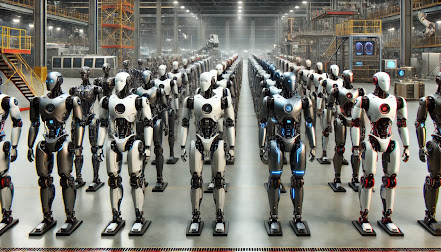Enovix ($ENVX on Nasdaq) has developed a unique new Li battery that will enhance safety, longevity and higher energy levels
Here are some of the top companies that produce commodities essential for the robotics industry, along with an indication of which might be suitable for small investors to consider:
1. Copper
- Top Companies: Freeport-McMoRan, BHP Group, Southern Copper Corporation
- Small Investor Consideration: Freeport-McMoRan (FCX) - Known for its large-scale mining operations, it's a prominent name with considerable market presence.
2. Steel
- Top Companies: ArcelorMittal, Nippon Steel, China Baowu Steel Group
- Small Investor Consideration: ArcelorMittal (MT) - A global leader in steel production with diversified operations.
3. Lithium
- Top Companies: Albemarle Corporation, SQM, Livent Corporation
- Small Investor Consideration: Albemarle Corporation (ALB) - One of the largest producers of lithium, benefiting from the growing demand for electric vehicles and batteries.
4. GPUs (Graphics Processing Units)
- Top Companies: NVIDIA, AMD, Intel
- Small Investor Consideration: NVIDIA (NVDA) - Leading in high-performance GPUs with strong growth in AI and data centers.
5. Aluminum
- Top Companies: Alcoa Corporation, Rio Tinto, Norsk Hydro
- Small Investor Consideration: Alcoa Corporation (AA) - A key player in the aluminum industry with a strong market position.
6. Rare Earths
- Top Companies: Lynas Rare Earths, MP Materials, China Northern Rare Earth Group High-Tech Co.
- Small Investor Consideration: MP Materials (MP) - A significant rare earth producer in the U.S., benefiting from strategic importance in high-tech industries.
7. Silicon
- Top Companies: Wacker Chemie AG, Hemlock Semiconductor, Dow Corning
- Small Investor Consideration: Wacker Chemie AG - A leading global producer of polysilicon, essential for semiconductors and solar panels.
8. Carbon Fiber
- Top Companies: Toray Industries, Hexcel Corporation, Teijin Limited
- Small Investor Consideration: Hexcel Corporation (HXL) - A leading advanced composites company with a focus on carbon fiber.
9. Kevlar
- Top Companies: DuPont, Teijin Aramid, Kolon Industries
- Small Investor Consideration: DuPont (DD) - Known for its innovation and production of high-strength materials like Kevlar.
10. LiDAR
- Top Companies: Velodyne Lidar, Luminar Technologies, Aeva Technologies
- Small Investor Consideration: Luminar Technologies (LAZR) - An emerging leader in LiDAR technology with significant partnerships in the automotive sector.
11. Advanced Plastics
- Top Companies: BASF, SABIC, Dow Inc.
- Small Investor Consideration: Dow Inc. (DOW) - A major player in the chemicals and advanced plastics sector with a diverse product portfolio.
Several publicly traded companies are involved in the production of robots, robotics, or robot parts.
Notable examples include:
- Fanuc (FANUY): Specializes in industrial robots for manufacturing, including electrical injection molding machines and automated lasers.
- UiPath (PATH): Develops robotic process automation (RPA) software to enhance robot efficiency and learning.
- AeroVironment (AVAV): Produces unmanned aircraft systems used by the military and for research.
- Amazon (AMZN): Implements autonomous robots in its fulfillment centers.
These companies represent a range of applications from industrial automation to military and commercial use (Built In).
For small investors, considering companies with established market presence, strong financials, and clear growth potential in the robotics and related sectors is crucial. Companies like NVIDIA, Albemarle, and MP Materials offer a balance of growth potential and relative stability, making them attractive options for investment.



